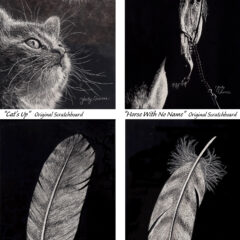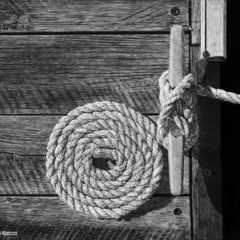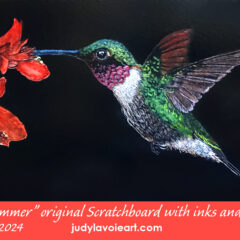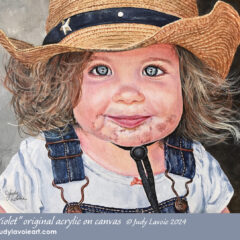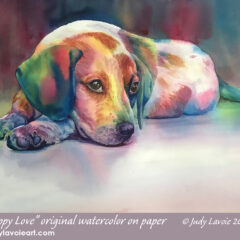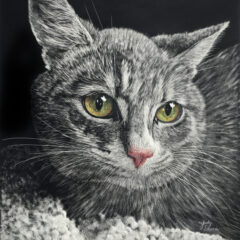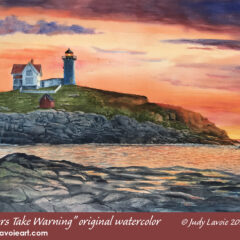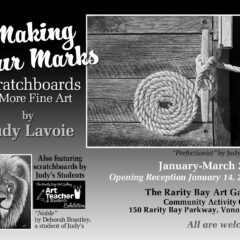Colorful cows, delicate flowers, cute pets, interesting faces, tranquil rural scenes – my online galleries are filled with pretty pictures. “Distress” is a departure for me, intentionally, and I’ve attempted a change in my style on this watercolor as well.
What story does this painting tell you? How do you think the man feels and why? I designed and composed the image to be thought-provoking, moving and ambiguous. My goal was to prompt an emotional response. When I finished this painting several weeks ago, some who saw it reacted with intense feelings. Today, amid the fears and uncertainties of the coronavirus, I think the impact of this image might be even stronger.
I also set out to paint in a different style than I have before. I wanted to blend realism with a bit of abstraction (a big challenge for me), mix tightness with looseness (another tough one), and use more subdued colors than usual. I wanted to include symbolism with open interpretation. The composition includes multiple elements, which I aimed to position and balance in a way that wouldn’t distract from the focal point of the figure.
I don’t remember exactly what seeded the concept for this painting, but it goes back over a year. The image of a distraught figure and the upside-down flag (a signal of distress) came first, and other elements morphed into the scene later. My husband Rick posed for the figure, seated on a piano stool I set outside in natural light. I did three photos of him in profile, shooting at eye level from the side which showed the American flag on his sleeve. The left sleeve has the insignia for his department, but I did not want to identify the uniformed figure’s affiliation. As I hoped, viewers who have given me feedback presume this is either a military, law enforcement, government, or other official. Of the three photos of Rick, any of the three were perfect, so I was out of the gate with my visual concept.
Last summer I took dozens and dozens and dozens of photos of flags and of flags reflected in puddles. Fortunately the main streets of my little town were lined with flags for weeks around July 4th and we had many rain showers, so raw material was everywhere. Since I never intended for the figure to be painted sitting on a piano stool, I also photographed outdoor seating options: masonry steps, iron benches, rock walls, concrete garden benches. I ultimately used my photo of a seat made of stone-covered cement, located outside a local funeral home, although it doesn’t show much in the final painting. I photographed various settings too, including a busy main thoroughfare in a nearby city, buildings around our local town square, a random street corner, an old train depot. In the end I felt too much background info was distracting from the other elements so I simplified that component.
With the magic of Photoshop (and decades of professional experience with the software), I was able to silhouette the figure and combine it with my various other reference photos to create my composition. The screen shot of my working Photoshop file, with the many layers shown in the palette to the right of my imagery, illustrates how I struggled to find the best choices of these elements and a satisfying arrangement. in the end, I also downloaded an image of the U.S. Constitution and positioned a portion of it to be merely be a suggestion, but in balance with the puddle image from a design point of view.
 Rather than my usual bright hues, for this painting I selected a limited palette of earthy primary colors: Yellow Ochre, Alizarin Crimson, and Ultramarine Blue. I painted color swatches to get familiar with the mixtures I’d be able to create, hoping to mix an “olive drab green” for the pants and tan for the shirt. I decided to add Cadmium Yellow for livelier mixes of skin tones and for the red stripes on flag. I also added Prussian Blue so I could mix rich darks.
Rather than my usual bright hues, for this painting I selected a limited palette of earthy primary colors: Yellow Ochre, Alizarin Crimson, and Ultramarine Blue. I painted color swatches to get familiar with the mixtures I’d be able to create, hoping to mix an “olive drab green” for the pants and tan for the shirt. I decided to add Cadmium Yellow for livelier mixes of skin tones and for the red stripes on flag. I also added Prussian Blue so I could mix rich darks.
 Since this image was new territory for me, I started a small “practice” painting, in a vertical format. I love fabric and textures, so the uniform turned out to be the easy part, but making a reflection in a puddle proved more challenging. I didn’t finish the practice painting; I took it as far as needed to prove to myself it could work. It also convinced me to simplify the background and setting as much as possible. That’s when the idea of getting more loose and abstract beyond the figure and flag developed. I also determined that the painting would work better with tighter cropping; no need to include the bench, the lower legs and the boots, or so much space above the figure. So I converted to a horizontal format for the larger painting.
Since this image was new territory for me, I started a small “practice” painting, in a vertical format. I love fabric and textures, so the uniform turned out to be the easy part, but making a reflection in a puddle proved more challenging. I didn’t finish the practice painting; I took it as far as needed to prove to myself it could work. It also convinced me to simplify the background and setting as much as possible. That’s when the idea of getting more loose and abstract beyond the figure and flag developed. I also determined that the painting would work better with tighter cropping; no need to include the bench, the lower legs and the boots, or so much space above the figure. So I converted to a horizontal format for the larger painting.
I selected a full 30″ x 22″ sheet of Arches watercolor paper. I cropped my composition in Photoshop then sketched it onto the stiff 300lb cold-pressed (ie. textured) paper. I did not use any masking fluid, knowing I would be able to preserve white areas, like the stripes on the flag, as I painted around them.
 We had very rainy weather as I began working on this painting in February and I couldn’t photograph my work in progress as I usually do: outdoors, in natural light. Therefore, the first step in my progress collage is a bit further along than I typically show. I laid in colors at the top of my watercolor paper with broad strokes, wetting the paper first. I pre-mixed the colors on my palette first. I worked the dark colors on a slight diagonal, since that creates movement and it echoes the slant of the figure’s back and the opposing angle of the flag. At the top left I’d eventually add part of the US Constitution, so I created a parchment-like color and texture of old paper. As always, I relished painting the fabric of the uniform, with the folds, pockets, buckled seams and other details. The holstered gun and duty belt were interesting to depict, a black mass of shapes somewhat defined by highlights and reflected light. Slowly I worked on the details of the figure, my focal point – obviously painting him in a very realistic manner… except for giving Rick a head of brown hair instead of white!
We had very rainy weather as I began working on this painting in February and I couldn’t photograph my work in progress as I usually do: outdoors, in natural light. Therefore, the first step in my progress collage is a bit further along than I typically show. I laid in colors at the top of my watercolor paper with broad strokes, wetting the paper first. I pre-mixed the colors on my palette first. I worked the dark colors on a slight diagonal, since that creates movement and it echoes the slant of the figure’s back and the opposing angle of the flag. At the top left I’d eventually add part of the US Constitution, so I created a parchment-like color and texture of old paper. As always, I relished painting the fabric of the uniform, with the folds, pockets, buckled seams and other details. The holstered gun and duty belt were interesting to depict, a black mass of shapes somewhat defined by highlights and reflected light. Slowly I worked on the details of the figure, my focal point – obviously painting him in a very realistic manner… except for giving Rick a head of brown hair instead of white!
The reflected flag and the ground around it were painted next. After completing Step 7, I set the painting aside where I could look at it as I went about other tasks, to make myself more objective. The figure seemed to be competing for attention with the flag reflection. My solution: weaken the flag, strengthen the figure. To weaken the flag I rewet the red stripes and blue star field, working on small sections at a time, and blotted away some of the color while also softening some edges. I altered the ground surrounding the puddle, discarding my original plan to make it look like gravel and using spattered grey tones instead. I then painted stronger contrasts in areas of the figure, particularly on his hair, hands and arms, and on the small sections of his face which are visible. These adjustments seemed to improve emphasis on the figure itself.
My final step was to add the lettering at the top left. I downloaded a copy of the US Constitution and sized it in Photoshop. I printed just the top section on letter-size paper in greyscale (on my trusty old black and white laser printer) and taped the sheets together. I used artist’s graphite carbon paper, which is erasable, to trace the lettering onto my painting, aided by a small ruler to draw the straight lines of the lovely calligraphy. I have a very steady hand and I’ve done a great deal of calligraphy and hand lettering on documents, signs and banners over the years. All I needed for these letters was a brush with a good point. You will notice in the photo that I turned my painting upside-down to paint the lettering, for two reasons. First, the letters appear at the top of the paper, so it was easier to reach that area with the top at the bottom. Second, my brain stopped thinking of letters and just concentrated on the shapes and lines by turning the sheet, the same trick I’ve used for painting faces. The words of the preamble fade into the dark areas of my background, leaving just a few words readable: “We the People of the United States…insure domestic tranquility, provide for the common defense….” These words seem most appropriate for the imagery in the painting. The distinctive calligraphic lettering [hopefully] makes it obvious what the document is.
I think this painting stretched me in good ways and fulfilled my goal of creating an emotional image. As one of two paintings I recently entered into a juried watercolor competition, “Distress” was passed over and my other entry (“Like A Rainbow”) was accepted. I had hoped this new painting would get into the exhibition, but a juror’s choice is always subjective. I was thrilled to get one into the show, the 2020 Southern Watercolor Society Exhibition. There will be other shows for submitting “Distress.”


